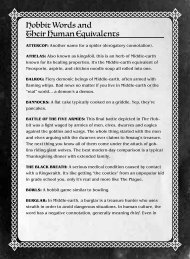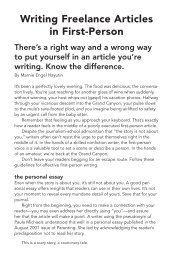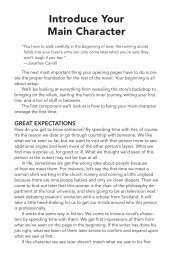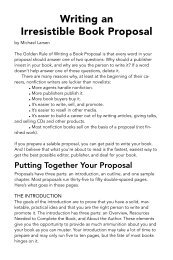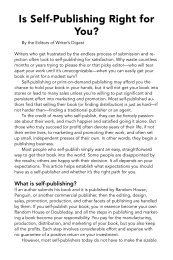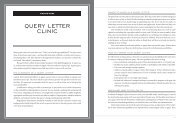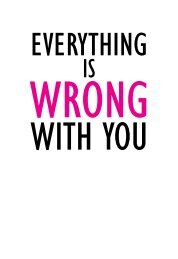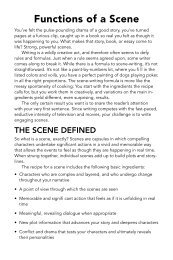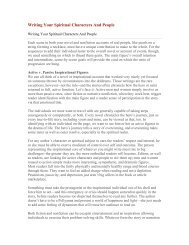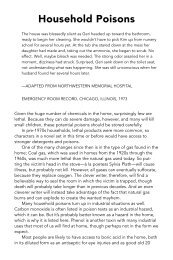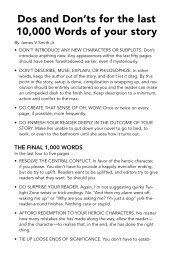Writing Young Chapter Books - Writer's Digest
Writing Young Chapter Books - Writer's Digest
Writing Young Chapter Books - Writer's Digest
You also want an ePaper? Increase the reach of your titles
YUMPU automatically turns print PDFs into web optimized ePapers that Google loves.
<strong>Writing</strong> <strong>Young</strong> <strong>Chapter</strong><br />
<strong>Books</strong><br />
Here’s what you need to know about<br />
this often overlooked genre.<br />
BY LYNN E. HAZEN<br />
Here was my situation—I had two books published, a picture book and<br />
a middle grade novel. My unfinished YA novel was taking up all my time<br />
and creative writing energy. So I didn’t need the distraction of yet another<br />
story idea in a new genre—but it can be hard to ignore your muse<br />
when inspiration comes calling.<br />
I was returning from a field trip to our neighborhood library with my<br />
preschool class when a young girl’s shoe fell off right in the middle of<br />
the crosswalk. The teacher holding her hand didn’t notice, so the girl<br />
hopped, leaving her shoe behind, all the way across the busy intersection.<br />
Without missing a beat, a boy behind her deftly scooped up her<br />
shoe, carried it to the curb, and knelt to help her put it back on. The<br />
event was quick, completely unexpected, and had a key moment of<br />
tension and an emotionally satisfying “aha” feeling at the end. All good<br />
elements for a story. It reminded me of the glass slipper scene in Cinderella,<br />
only better because this scene was funnier and more spontaneous.<br />
Inspired to try to capture the spunk of the hopping shoeless girl and her<br />
charming friend, I thought of the title—Cinder Rabbit—even before we<br />
arrived back at preschool.<br />
That evening I sat down to write. But write what I had a title, a quick<br />
scene followed by an “aha” moment, and … and … nothing else.<br />
I did have lots of questions. Were my characters bunnies We’ve all<br />
heard “No more talking bunnies!” OK, humans then in a school-related<br />
story But with Cinder Rabbit as my title, how would I accomplish that<br />
And would this be a picture book or a book with chapters What genre<br />
would best suit my story Forget about genre—what story I only had a<br />
title and an idea, but I hadn’t captured a single word on paper!<br />
Fingers poised, no words written, self-doubt rising, I thought, I can’t<br />
write! But my fingers finally started moving and several hours later I had a<br />
creative, fun and messy first draft.<br />
Many revisions later I had several characters, a story problem (or two
or three) and unfolding events on paper. My critique group knows all too<br />
well how many times my characters flip-flopped from bunnies to humans<br />
to bunnies as I wrote and rewrote my story. Not only did my characters’<br />
mammal species change, so did my genre. At first I aimed for a picture<br />
book, happy with the colorful language options available to me because<br />
picture books are meant to be read aloud by adults. But my story was<br />
getting longer—too long for a picture book, and I found myself writing<br />
<strong>Chapter</strong> One, <strong>Chapter</strong> Two … . Maybe it would be a beginning reader,<br />
but my Cinder Rabbit story seemed beyond the limited word count, and<br />
simple repetitive language and structure found in typical beginning readers.<br />
I still wasn’t sure of my genre, but in my creative process, I discovered<br />
that my characters were bunnies attending Grand Rabbits Elementary<br />
School, putting on the play of Cinder Rabbit. The star of the play must<br />
lead her class in the Bunny Hop, but when a classmate laughs at her, she<br />
forgets how to hop! Her tagline is, I can’t hop! Hmm, does her performance<br />
anxiety sound familiar You guessed it—at the heart of my bunny<br />
character was me—fingers poised over the keyboard that first evening<br />
trying to capture the story and thinking, I can’t write!<br />
When an editor asked me if I’d be interested in revising another<br />
picture book manuscript, The Amazing Trail of Seymour Snail, into a possible<br />
young chapter book, I of course said yes. In the meantime, I sent<br />
her my too-long-to-be-a-picture-book and too-complex-to-be-an-earlyreader<br />
version of Cinder Rabbit. Fast forward, imagine more revisions,<br />
and hooray; Henry Holt published both Cinder Rabbit and The Amazing<br />
Trail of Seymour Snail.<br />
What did my book turn out to be A young chapter book. So, is there<br />
a clear distinction between beginning readers and young chapter books<br />
Who are the readers of these books Is the young chapter books genre<br />
your genre, too Read on.<br />
<strong>Young</strong> <strong>Chapter</strong> <strong>Books</strong> vs. Beginning Readers<br />
Anastasia Suen, author of 106 children’s books, says the question she’s<br />
asked most is this: When does a beginning reader become a young<br />
chapter book This happens, she says, when the art no longer supports<br />
all of the text. “Look at an easy reader like Frog and Toad, by Arnold<br />
Lobel. The writer doesn’t describe everything in the scene because the<br />
child can see it in the art. The text is mainly action and dialogue. All of<br />
this changes in a chapter book. In Knights of the Kitchen Table, a chapter<br />
book by Jon Scieszka, there isn’t art on every page. Words describe the<br />
scenes. Adding description to the action and dialogue makes the stories
much longer.”<br />
San Francisco children’s librarian Kathleen Keeler says there are really<br />
no hard and fast rules for determining whether a title is a beginning<br />
reader or a young chapter book. “Many beginning readers have chapters<br />
so that is not a deciding factor. I estimate that beginning readers are<br />
usually 2,000 words or less (usually less) and that the sentences in beginning<br />
readers stand alone rather than being organized into paragraphs<br />
(which results in a lot of white space on the page, which is less intimidating<br />
to new readers than paragraphs),” she says. “In addition the plots are<br />
simpler in beginning readers, with the protagonist grappling with a single<br />
problem per book (or per chapter when each chapter is a stand-alone<br />
story). <strong>Chapter</strong> books may have multi-layered plots and problems, and<br />
even subplots.”<br />
Still, it can be hard to tell the difference since both easy readers and<br />
chapter books have chapters. “You can see the difference between an<br />
easy reader with chapters and a chapter book by putting two book pages<br />
side by side,” says Suen. “The easy reader page has color art and a large<br />
font. A chapter book page has black-and-white (or grayscale) art and a<br />
smaller font.”<br />
A knowledgeable children’s bookseller notes that a big difference between<br />
beginning readers and chapter books is that the art in beginning<br />
readers is essential for the young reader—that it is usually a literal visual<br />
translation of the text in order to help the beginning reader decode the<br />
words. The art in chapter books, on the other hand, is more decorative or<br />
entertaining and is not meant to help the reader decode the words. And<br />
most young chapter books’ illustrations are in black and white, such as<br />
in the popular Ivy and Bean and Junie B. Jones series (though there are<br />
exceptions, such as the colorful illustrations in the Mercy Watson young<br />
chapter book series by Kate di Camillo).<br />
Who Reads <strong>Young</strong> <strong>Chapter</strong> <strong>Books</strong><br />
Just who makes up the audience for young chapter books How old are<br />
they What are their grade levels “When, as a children’s librarian, I introduce<br />
children and their caregivers to our beginning readers, I explain<br />
that readers are for children Kindergarten to third grade roughly and that<br />
the young chapter books (we call them younger reading titles) are from<br />
second through fourth grade,” says Keeler. “Working in the public library,<br />
I want to list a broad range of ages since I don’t want to insult an older<br />
child reading at a younger reader level. For average to good readers,<br />
though, I would estimate that most children outgrow beginning readers<br />
in first or second grade, and that solid readers like reading chapter books
in second, third and sometimes fourth grade.”<br />
<strong>Chapter</strong> book series are something young readers love. “Children<br />
learning to read (which applies to beginning readers and chapter books<br />
both) gravitate toward series,” Keeler says. “Reading a new title in a series<br />
that they have already succeeded with gives them extra confidence<br />
and pleasure in the reading experience. Because of this, I think providing<br />
series to children as they learn and solidify their reading skills is even<br />
more important than with older children reading longer middle-grade<br />
juvenile fiction.”<br />
“One of the things that I hear most often from teachers and librarians<br />
is that they want more early chapter books, not only to help them teach<br />
children the basic skills but also to get children excited about reading,”<br />
says Henry Holt Senior Editor Reka Simonsen. “And the ALA’s recent<br />
creation of the Geisel Award certainly supports this. On the other hand,<br />
there still doesn’t seem to be a very big market for hardcover chapter<br />
books. Perhaps that’s why the larger houses with established easy-reader<br />
programs tend to publish those books in paperback first, and tend to do<br />
series.”<br />
My bookseller friend notes that children at this stage love series such<br />
as A-Z Mysteries, Cam Jansen, Junie B. Jones, Mercy Watson, The Magic<br />
Treehouse and more.<br />
And there are many other examples of great young chapter books<br />
and chapter book series out there. “I love the Good Knight books by<br />
Shelley Moore Thomas, which are on the younger, just-beginning-to-read<br />
end of the spectrum,” Simonsen says. “And of course Arnold Lobel’s<br />
Frog and Toad books set the gold standard. For more experienced readers,<br />
I think the Ivy and Bean books by Annie Barrows and the Clementine<br />
books by Sara Pennypacker are terrific.”<br />
If you’re curious about reading levels, word count and page ranges of<br />
various books, Amazon.com offers a useful feature—“Text Stats.” Listed<br />
under the “Inside This Book” section on a book’s Amazon page (following<br />
“Product Details”), “Text Stats” reveals not only how many pages the<br />
finished book has, but also the number of words, sentences and words<br />
per sentence, along with various readability indexes.<br />
At RenLearn.com there is a nifty search tool outlining the interest<br />
level, book level, word count and number of pages in many children’s<br />
books, as well as various awards, booklists and groupings. (From Ren-<br />
Learn.com, click on “store,” then “quiz search,” then search for a particular<br />
title or author.)<br />
While it might be useful and fun to see these text stats and reading<br />
levels on Amazon or RenLearn, my advice is that once you click around
a bit, once you’ve immersed yourself in reading favorite titles, just forget<br />
about specific word counts and reading levels. Instead stay focused on<br />
the heart of your story. Aim for accessibility by creating a strong story<br />
with interesting, fun and emotionally real characters.<br />
“When I’m writing a first draft, I try not to get too hung up on word<br />
length or classifications like ‘chapter book’ or ‘reader,’ ” says Deborah<br />
Underwood, author of 12 children’s books including the popular Pirate<br />
Mom. “Once the story is in place, if it feels more like an easy reader, I<br />
can simplify the vocabulary and sentence structure. If it feels more like a<br />
chapter book, I can add subplots. It seems to me that editors are primarily<br />
concerned with finding strong stories.” K•YA<br />
Lynn E. Hazen (lynnhazen.com) writes books filled with humor, heart and<br />
hope. She is the author of the young adult novel Shifty, which was chosen<br />
for VOYA’s Top Shelf Fiction, as a CCBC Choice and a Smithsonian Notable.<br />
Her younger books include Mermaid Mary Margaret, Cinder Rabbit,<br />
The Amazing Trail of Seymour Snail, and Buzz Bumble to the Rescue. She<br />
teaches courses in writing for children and young adults at Stanford Continuing<br />
Studies.



